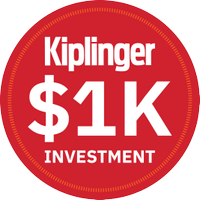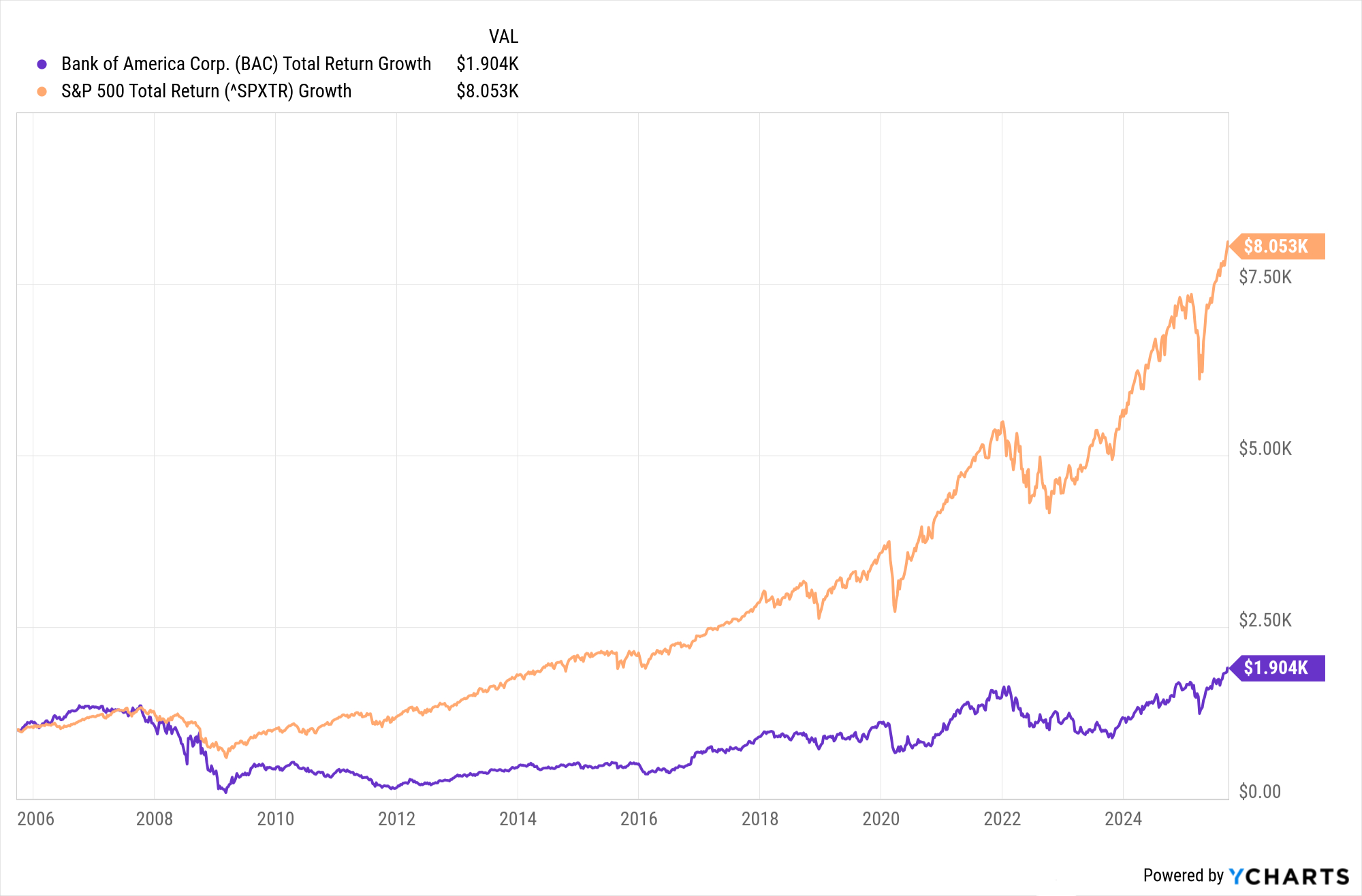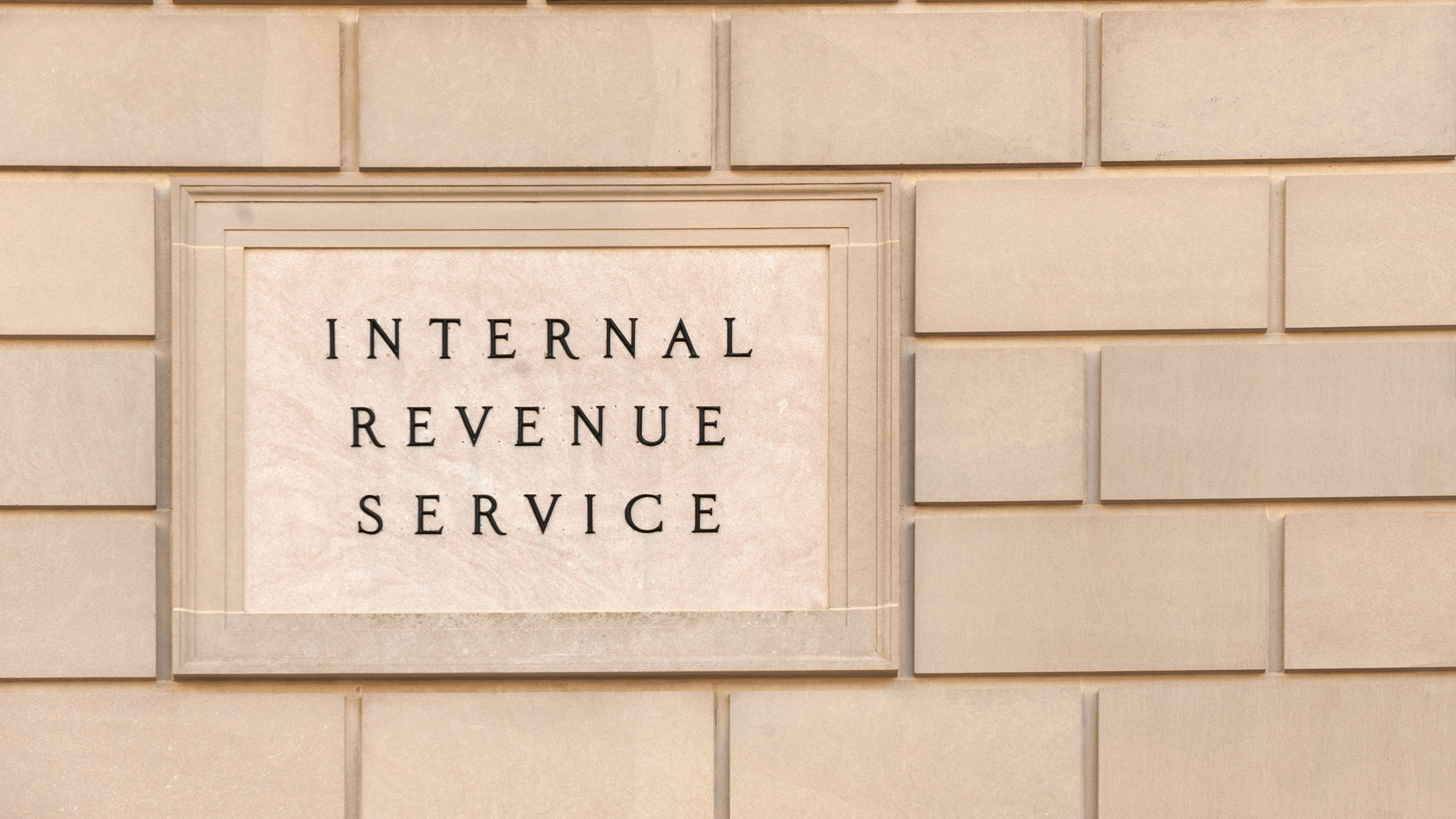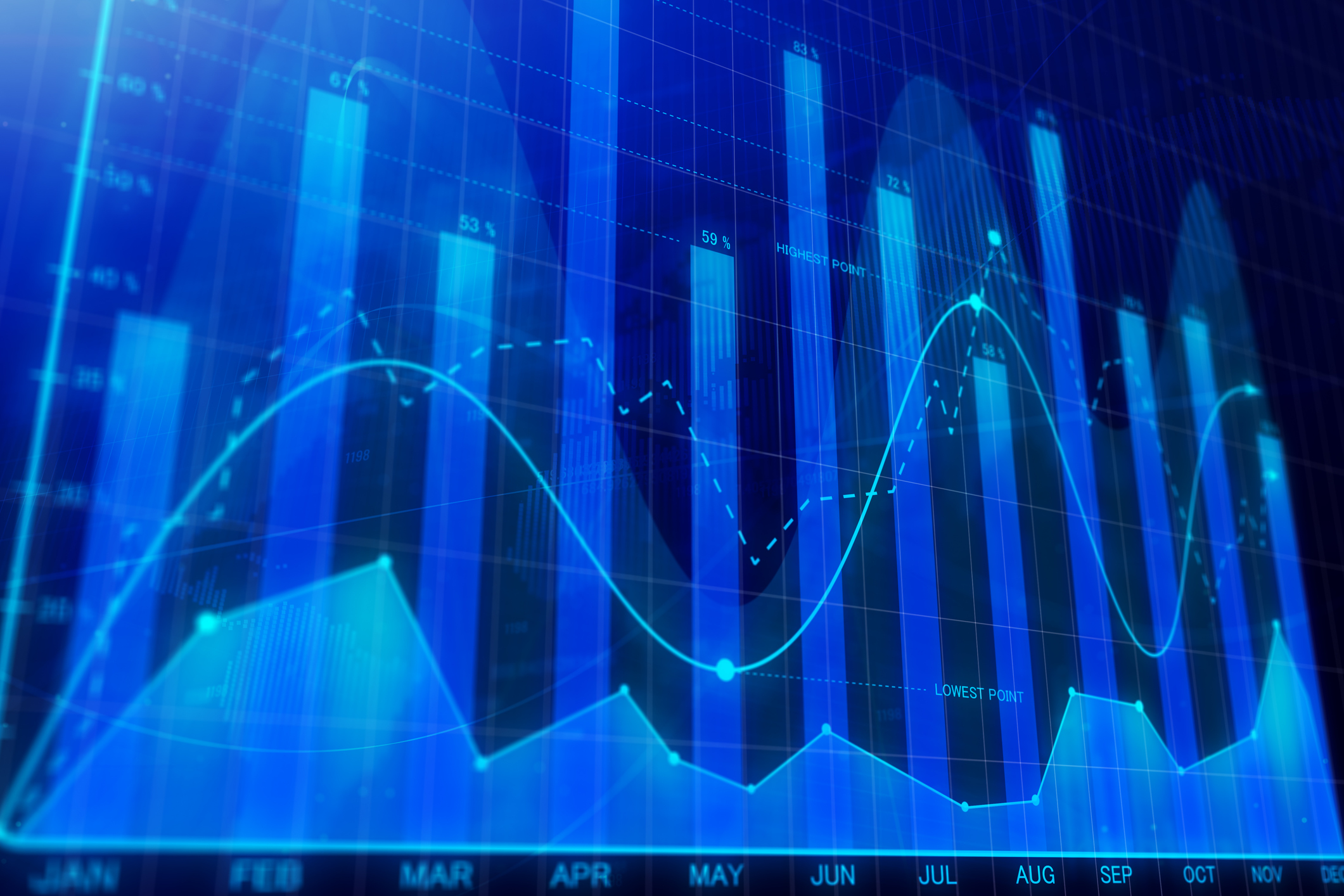If You'd Put $1,000 Into Bank of America Stock 20 Years Ago, Here's What You'd Have Today
Bank of America stock has been a massive buy-and-hold bust.



Bank of America (BAC) stock has been one of the better bets among large-cap financials in the past few years — but as a long-term holding, it leaves everything to be desired.
True, shares in the nation's second biggest bank by assets generated an annualized total return (price change plus dividends) of more than 20% in the past five years. That beats the broader market by about 4 percentage points.
It's not for nothing that BAC remains one of Warren Buffett's favorite stocks. Berkshire Hathaway initiated a position in BAC in the third quarter of 2017. While Buffett has exited stakes in a host of other financial names through the years, BAC is still Berkshire's third-largest holding.
From just $107.88 $24.99 for Kiplinger Personal Finance
Become a smarter, better informed investor. Subscribe from just $107.88 $24.99, plus get up to 4 Special Issues

Sign up for Kiplinger’s Free Newsletters
Profit and prosper with the best of expert advice on investing, taxes, retirement, personal finance and more - straight to your e-mail.
Profit and prosper with the best of expert advice - straight to your e-mail.
BAC accounts for more than 11% of the value of Berkshire's U.S. equity portfolio. Meanwhile, with more than 8% of its shares outstanding, Berkshire is Bank of America's second-largest investor after Vanguard.
It's hard not to like a stock so beloved by Warren Buffett, especially when he's gone out of his way to praise the bank's management.
Wall Street likes BAC, too. Of the 25 analysts covering the stock surveyed by S&P Global Market Intelligence, 14 rate it at Strong Buy, seven say Buy, three have it at Hold, and one calls it a Sell. That works out to a consensus recommendation of Buy, with very high conviction.
"We believe that the current BAC share price undervalues the franchise given ongoing improvement in return metrics and continued positive operating leverage," writes Argus Research analyst Stephen Biggar, who rates the financial stock at Buy.
As bright as BAC's prospects might be, shares have been a truly dreadful buy-and-hold bet.
Blame the Great Recession
Bank of America was formed when NationsBank acquired BankAmerica in the late 1990s to create the country's first coast-to-coast bank. The firm followed up with other megadeals, such as scooping up FleetBoston Financial, MBNA and U.S. Trust.
Sadly, the bank's hunger for deals was ultimately its undoing.
When the housing market imploded and the Great Recession hit, Bank of America went shopping. The firm's acquisition (with government assistance) of Merrill Lynch worked out. Its purchase of Countrywide, then the nation's largest mortgage lender, did not.
With a deal price of about $4 billion in stock, Countrywide looked like a fire-sale bargain. Instead, it saddled BAC with hundreds of billions of dollars in bad loans and tens of billions of dollars in legal settlements.
A stock that traded north of $50 in 2007 went for less than $5 in March 2009. More than four years later, BAC stock was still below $15. That made shares essentially immaterial among the price-weighted Dow Jones stocks. In the fall of 2013, BAC was replaced in the blue-chip barometer by Goldman Sachs (GS).
The bottom line on Bank of America stock
Bank of America has been a terrible buy-and-hold bet. In its entire life as a publicly traded company, BAC has generated an annualized total return of just 4.3%. The S&P 500, by comparison, returned 10.8% in the same time frame.
Shares also lag the broader market in the past 10 and 15 years. True, the stock has been a winner in the past five years — and doubles the performance of the S&P 500 in the past 52 weeks.
But for the past two decades? It's sort of unforgivable.

Have a look at the above chart, and you'll see that if you invested $1,000 in BAC stock 20 years ago, today your stake would be worth about $1,900 — good for an annualized total return of 3.3%.
The same amount invested in the S&P 500 would theoretically be worth about $8,000 today, or an annualized total return of almost 11%.
Past performance is not a guarantee of future results. Let us pray we never see something like the Great Recession again.
If nothing else, BAC's 20-year return shows how the damage inflicted by the global crisis continues to haunt investors to this day.
More Stocks of the Past 20 Years
- If You'd Put $1,000 Into Oracle Stock 20 Years Ago, Here's What You'd Have Today
- If You'd Put $1,000 Into Berkshire Hathaway Stock 20 Years Ago, Here's What You'd Have Today
- If You'd Put $1,000 Into Apple Stock 20 Years Ago, Here's What You'd Have Today
Profit and prosper with the best of Kiplinger's advice on investing, taxes, retirement, personal finance and much more. Delivered daily. Enter your email in the box and click Sign Me Up.

Dan Burrows is Kiplinger's senior investing writer, having joined the publication full time in 2016.
A long-time financial journalist, Dan is a veteran of MarketWatch, CBS MoneyWatch, SmartMoney, InvestorPlace, DailyFinance and other tier 1 national publications. He has written for The Wall Street Journal, Bloomberg and Consumer Reports and his stories have appeared in the New York Daily News, the San Jose Mercury News and Investor's Business Daily, among many other outlets. As a senior writer at AOL's DailyFinance, Dan reported market news from the floor of the New York Stock Exchange.
Once upon a time – before his days as a financial reporter and assistant financial editor at legendary fashion trade paper Women's Wear Daily – Dan worked for Spy magazine, scribbled away at Time Inc. and contributed to Maxim magazine back when lad mags were a thing. He's also written for Esquire magazine's Dubious Achievements Awards.
In his current role at Kiplinger, Dan writes about markets and macroeconomics.
Dan holds a bachelor's degree from Oberlin College and a master's degree from Columbia University.
Disclosure: Dan does not trade individual stocks or securities. He is eternally long the U.S equity market, primarily through tax-advantaged accounts.
-
 IRS Says You Made a Tax Return Mistake? A New Law Could Help You Fight Back
IRS Says You Made a Tax Return Mistake? A New Law Could Help You Fight BackTax Law Updated taxpayer protections change what the IRS must explain on error notices and how long you have to respond.
-
 What to expect from the global economy in 2026
What to expect from the global economy in 2026The Kiplinger Letter Economic growth across the globe will be highly uneven, with some major economies accelerating while others hit the brakes.
-
 What You Need to Do With Your 401(k) Before 2025 Is Over
What You Need to Do With Your 401(k) Before 2025 Is OverBefore 2025 ends, check your 401(k) contributions, investments, and catch-up eligibility to lock in this year’s tax savings and employer match.
-
 I'm a Tax Attorney: These Are the Year-End Tax Moves You Can't Afford to Miss
I'm a Tax Attorney: These Are the Year-End Tax Moves You Can't Afford to MissDon't miss out on this prime time to maximize contributions to your retirement accounts, do Roth conversions and capture investment gains.
-
 I'm an Investment Adviser: This Is the Tax Diversification Strategy You Need for Your Retirement Income
I'm an Investment Adviser: This Is the Tax Diversification Strategy You Need for Your Retirement IncomeSpreading savings across three "tax buckets" — pretax, Roth and taxable — can help give retirees the flexibility to control when and how much taxes they pay.
-
 Dow Rises 497 Points on December Rate Cut: Stock Market Today
Dow Rises 497 Points on December Rate Cut: Stock Market TodayThe basic questions for market participants and policymakers remain the same after a widely expected Fed rate cut.
-
 Could an Annuity Be Your Retirement Safety Net? 4 Key Considerations
Could an Annuity Be Your Retirement Safety Net? 4 Key ConsiderationsMore people are considering annuities to achieve tax-deferred growth and guaranteed income, but deciding if they are right for you depends on these key factors.
-
 I'm a Financial Pro: Older Taxpayers Really Won't Want to Miss Out on This Hefty (Temporary) Tax Break
I'm a Financial Pro: Older Taxpayers Really Won't Want to Miss Out on This Hefty (Temporary) Tax BreakIf you're age 65 or older, you can claim a "bonus" tax deduction of up to $6,000 through 2028 that can be stacked on top of other deductions.
-
 JPMorgan's Drop Drags on the Dow: Stock Market Today
JPMorgan's Drop Drags on the Dow: Stock Market TodaySmall-cap stocks outperformed Tuesday on expectations that the Fed will cut interest rates on Wednesday.
-
 Meet the World's Unluckiest — Not to Mention Entitled — Porch Pirate
Meet the World's Unluckiest — Not to Mention Entitled — Porch PirateThis teen swiped a booby-trapped package that showered him with glitter, and then he hurt his wrist while fleeing. This is why no lawyer will represent him.
-
 Smart Business: How Community Engagement Can Help Fuel Growth
Smart Business: How Community Engagement Can Help Fuel GrowthAs a financial professional, you can strengthen your brand while making a difference in your community. See how these pros turned community spirit into growth.